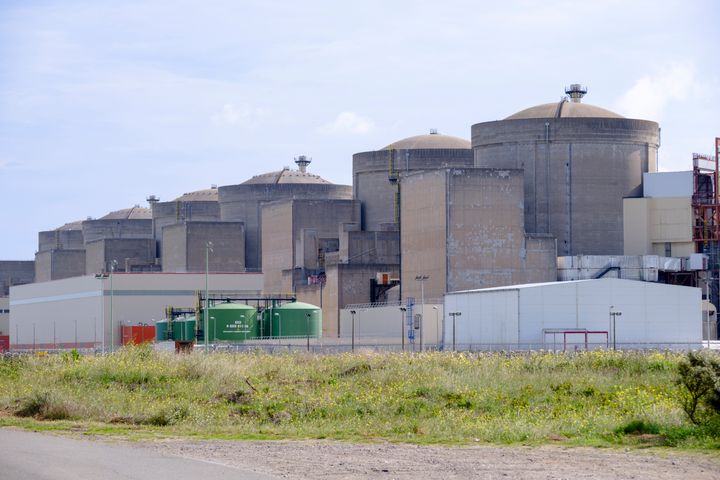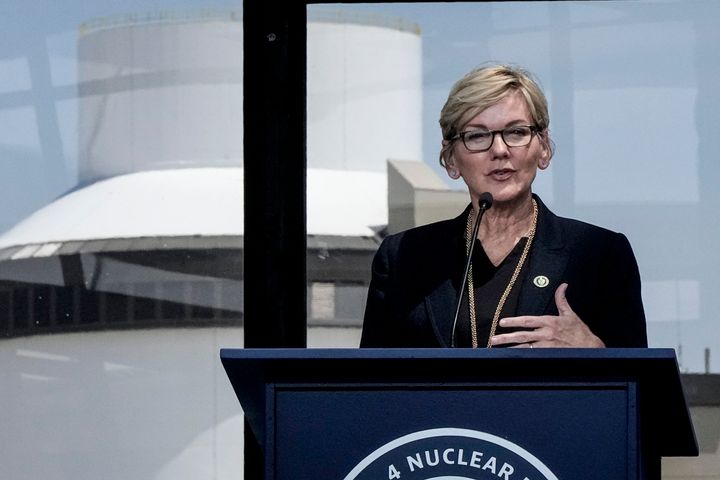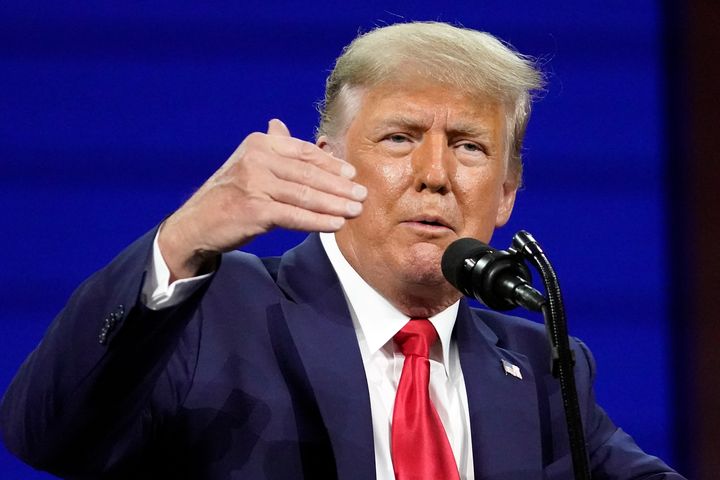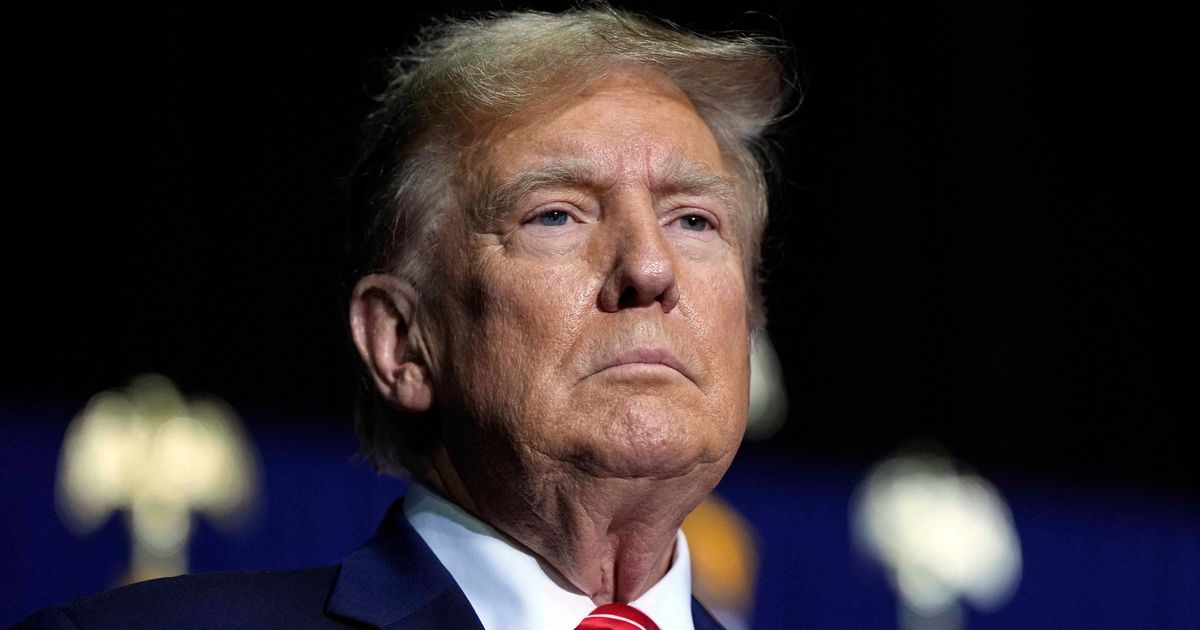Former President Donald Trump took a skeptical stance on nuclear energy in his recent interview with podcaster Joe Rogan, warning that the source of electricity Republican voters favor and GOP lawmakers vowed to support carries “dangers” and costs too much.
While the GOP nominee for president said atomic energy “is very clean” during his three-hour conversation with the popular comedian and sports commentator, he repeatedly cited the downsides of a technology his administration supported in the past and his campaign has now vowed to promote if he’s elected again next month.
“They get too big and too complex and too expensive,” Trump said.
“There’s a little danger to nuclear,” he continued. “You know, we had some really bad nuclear.”
Trump then name-checked two proposed reactor projects that went bust during his presidency. Six months after Trump took office, South Carolina abandoned its $9 billion plan to expand the Virgil C. Summer nuclear station, which ultimately saw two executives jailed for lying to regulators about the viability of the project. Trump also mentioned Alabama, where, just a few months after Trump left the White House, the Tennessee Valley Authority gave up construction permits for a new reactor after 47 years.
The only two new reactors the United States has built from scratch in decades came online in Georgia earlier this year. The legendary U.S. nuclear developer Westinghouse designed the AP-1000 reactors built at the site in the early 2000s, initially billing the model as the workhorse of the nuclear renaissance planned under George W. Bush’s administration.
Westinghouse had never built an AP-1000 before starting construction at utility giant Southern Company’s Alvin W. Vogtle Generating Station in 2012. Yet the companies involved in the plan asked the Nuclear Regulatory Commission for permission to build and operate the new reactors under a combined license that required the reactors to stick to the submitted blueprints to qualify.
Each time the reactor’s design was tweaked during construction, the developers needed to go back to the NRC for approval, sending the costs skyrocketing. By the time Southern Company hooked the second of the two Westinghouse reactors up to the grid in the U.S. this summer, the project cost upward of $35 billion.
Trump said he wanted to avoid telling a story “too long for the show” because Rogan’s widely followed podcast was “too valuable to talk about concrete.” But he said each time the super hard variety of concrete poured at the nuclear construction site failed to meet specifications, an inspector would say “you have to take down a 25-zillion-dollar wall.”
“These things ended up costing $25 billion,” Trump said. “And one of them never got opened.”
He suggested a solution: building the same kind of reactor over and over again.

Thierry Monasse via Getty Images
“France does it. France is largely nuclear,” Trump said. “And they build small, little, compact plants, and if they build more, they build the same thing and they hook it up.”
That’s partly right. France has generated the bulk of its electricity from nuclear plants since building more than 50 reactors between 1973 and 1990 as part of an effort to wean the country off foreign fuel imports following the 1973 oil embargo. At its largest nuclear station, the Gravelines plant on the French side of the English Channel, France constructed six identical reactors in a row. But they aren’t small. Each is capable of producing nearly 1,000 megawatts of electricity, roughly just as large and powerful as the reactors built in Georgia.
Faced with the mounting costs of the AP-1000 projects in Georgia, the U.S. nuclear industry pitched smaller, less powerful reactors called small modular reactors as a solution on the grounds that a power plant buying four at a time to equal the same output as one large unit would bring down construction costs through faster rates of learning.
But many so-called SMRs relied on plant designs that required similar amounts of concrete and other materials. That suggested the models would actually cost more than larger, traditional units since the less powerful SMRs lost the same economies of scale that come from reactors that generate 1,000 megawatts or more.
Massachusetts Institute of Technology researcher Koroush Shirvan estimated that another AP-1000 would be the cheapest type of reactor to build in the U.S. next because the design and supply chains are established, and there are now thousands of workers with experience constructing the technology. Indeed, so-called Plant Vogtle’s Unit 4 came in roughly 30% cheaper than Unit 3, Jigar Shah, the head of the Department of Energy’s Loan Programs Office, said recently.
But no new AP-1000s or any large-scale reactors are planned in the U.S. at the moment. Instead, Microsoft is paying $16 billion to help reopen the shuttered reactor at the Three Mile Island nuclear plant in Pennsylvania, and the Biden administration is putting up $1.5 billion to reopen the nation’s most recently shuttered atomic energy station in Michigan.
Forecasting large increases in electricity demand from their own data centers powering artificial intelligence, tech giants in recent weeks announced big investments into another kind of SMR design showing more promise. Google and Amazon both poured money into next-generation SMR companies, whose as-yet-unbuilt reactors use coolants other than water. Bill Gates’ reactor company, TerraPower, is constructing a similar type of pilot project reactor in Wyoming.

Nuclear power is the only major source of electricity in the U.S. that both Democrats and Republicans support in growing numbers. GOP-aligned voters still favor atomic energy by a double-digit margin in recent polling that nevertheless shows support among Democrats at the highest levels since Fukushima.
During his presidency, Trump signed executive orders and legislation supporting nuclear energy, but prioritized fossil fuels over reactors. The only major loan the Export-Import Bank of the United States issued under Trump was the federally-owned lender’s largest ― a $3 billion deal to help Poland build its first nuclear power plant using AP-1000 reactors.
Under President Joe Biden, the federal government took its most active role in half a century in preserving and expanding the nation’s fleet of nuclear power reactors. Biden’s landmark infrastructure laws contained billions in loans and tax credits for nuclear power, including the experimental reactors now entering into major commercial deals with tech companies.
The Trump campaign has pledged to continue expanding nuclear power if elected. Rep. Byron Donalds (R-Fla.), one of the most prolific sponsors of pro-nuclear legislation in Congress, is among Trump’s top campaign surrogates, and appeared alongside the former president onstage at Manhattan’s Madison Square Garden on Sunday evening.
Still, when first asked about nuclear power, Trump appeared to dodge Rogan’s question.
“Let me ask you about nuclear,” Rogan said. “One of the things when I’ve talked to people that have a real understanding of nuclear power, their position is it’s probably the cleanest, safest form of electricity we could generate, that the fears of nuclear power are really about a few disasters ― Fukushima, Three Mile Island.”

“These are old systems. They’re much more capable now, and they’re capable of making even better systems,” Rogan continued. “But it’s a political issue, you think nuclear power, you think Chernobyl.”
The 1986 nuclear accident in Soviet Ukraine remains the only major civilian nuclear accident with a death toll. Repeated federal studies failed to turn up any increase in diseases from radiation exposure as a result of the partial meltdown at Three Mile Island in 1979. Just one emergency worker died of cancer after 2011’s Fukushima, but scientists raise doubts over whether the man’s illness could be traced to radiation exposure at the facility.
Hundreds of mostly elderly Japanese died from stress as a result of the forced evacuation, but livestock left alive in the irradiated zone around the nuclear plant are showing few signs of disease from exposure, suggesting precautions around radiation may be stricter than needed to avoid health effects.
But Trump interjected, insisting to Rogan “you’re not supposed to enter the land for 3,000 years” around the Fukushima nuclear plant.
The former president then started talking about what he called “raw earths,” an apparent reference to “rare earths,” the family of metals needed for batteries and key military technologies, and over which China has a near monopoly on production. From there, Trump launched into a familiar diatribe about the tradeoffs of wind energy ― complaints Rogan piled onto.
Rogan redirected Trump to the initial question: “Would you replace that with nuclear? What would you do?”
Trump rattled off the issues with the concrete at Plant Vogtle in Georgia. Rogan asked if that was an example of overregulation by the NRC.
Trump noted how the French built reactors, then started talking about his uncle, the MIT electrical engineer John G. Trump.
“He knew everything,” Trump said of his uncle. “He said someday it’s going to be the way to go, but the problem is it’s so dangerous in terms of war.”
Trump said he imagined that someday, nuclear weapons could be small enough to fit in a backpack.
“He said someday, you’ll have a little satchel by your side, and you’ll be able to go into a building and blow up New York City,” Trump said.
Rogan suggested the biggest problem with other countries building nuclear reactors, such as India and Pakistan, is that both nations built atomic bombs after the signing of the United Nations’ Treaty on the Non-Proliferation of Nuclear Weapons. Neither South Asian nation is a signatory to the treaty. But Trump seemed to affirm the connection between atomic bombs and civilian nuclear power, and downplayed the biggest reason for the revival of reactor construction: the need for more zero-carbon electricity to deal with climate change.
“The biggest problem in the world today isn’t global warming,” Trump said. “It’s nuclear warming.”
